Chinese History — Brief Introduction to Imperial Dynasties, Rise and Fall of Empires, and Important Historical Events
The history of China encompasses a vast chronicle, spanning from the Neolithic civilizations along the Yellow River and Yangtze River to the rise and fall of imperial empires, leading to the modern era.
Chinese history is marked by numerous separations, unifications, conflicts, and prosperity.
It unfolds through successive Imperial Dynasties propelled by influential Historical Figures and, most significantly, shaped by the countless civilians who have inhabited this land.
This introduction serves as a gateway to the epochs that defined China, unraveling stories of empires ascending to glory and descending into the annals of history.



Along the River During the Qingming Festival or Qingming Shang He Tu, Genre Painting of the Capital City (Bianjing or Kaifeng) of the Song Dynasty by Artist Zhang Zeduan (1085 — 1145) — The Palace Museum
Prehistoric Legends and Primitive Cultures — Chinese People's Ancestor Worship
There exists an ancient Chinese book, known as The Classic of Mountains and Seas, is estimated to have been completed around 5000 years ago, and its actual writer is unknown.
This remarkable book meticulously recorded hundreds of mountains, rivers, historical figures, mythical animals, states, legends, and customs, categorizing them based on their diverse geological locations.
According to the book's vivid portrayal of a wondrous and fantastic world, many prototypes described within can be identified in the present day.
It serves as a comprehensive collection depicting Primitive Society, myth, and legend, describing an era teeming with mysterious immortals and influential heroes.
During this period, numerous Primitive Cultures were scattered across mainland China, blurring the boundary between the human and immortal worlds.
Supernatural beings could traverse into the mortal world to aid people, and outstanding mortals could ascend to become deities through their remarkable accomplishments.

Jade Dragon of Hongshan Culture (Around 4000 BC — 3000 BC) — National Museum of China
Together, deities and humans reshaped the world, fostering a better place to live through their diligence, strong will, and exceptional courage.
This was the origin of Chinese people’s Ancestor Worship and the initial stages of Chinese culture.
Among the human superheroes, those highly accomplished ascended to become sovereigns of prominent tribes.
Two of the most influential figures were the Flame Emperor(Yan Di) and the Yellow Emperor (Huang Di), widely acknowledged as the ancestors of all Chinese people.

Red-crowned Crane Bone Made Flute, Peiligang Culture (About 7000 — 8000 Years Ago) — Henan Antique Archaeology Institute (Photo by Dongmaiying)
Xia Dynasty — First Hereditary Empire in Chinese History
Yu the Great was the hero who led the people to successfully defeat a vast flood, and he is also considered one of the possible writers of the Classic of Mountains and Seas.
After obtaining the throne from King Shun, Yu the Great established the Xia Dynasty (about 2070 BC — 1600 BC), marking the first hereditary empire in the history of China.
Although more concrete archaeological evidence is still required to definitively prove the existence of the Xia Dynasty, many Chinese historical documents and pieces of literature already clearly record and describe this empire, even though most are simple and brief.
In 1600 BC, the Lord of the State Shang initiated wars against King Jie of Xia. After a series of intense battles, they emerged victorious.
King Jie was subsequently banished to a desolate mountain, where he passed away, marking the end of the Xia Dynasty.

Bronze Artifact Decorated with Turquoise Unearthed From Erlitou Site, Which is believed to be the Relic Site of part of the Xia Dynasty — Institute of Archaeology, Chinese Academy of Social Sciences (Photo by Dongmaiying)
Shang Dynasty — Era of Oracle Bone Scripts and Superstition Worship
There was a clan named Shang that once regarded the Kings of the Xia Dynasty as their sovereigns.
Centuries later, Shang's current lord, Tang, successfully overthrew the last king of Xia and, in doing so, established the Shang Dynasty (1600 BC — 1046 BC).
This dynasty holds a unique place in Chinese history as the first documented directly using Chinese Characters.
People recorded crucial events on oracle bones, tortoise shells, and bronze wares during this period.
From that point forward, Chinese history has been documented clearly and continuously.

Unearthed Inscriptions on Bones regarding King Wu Ding’s Divination about Shang Empire — National Museum of China
The Shang Dynasty endured for over 500 years and was ruled by a total of 31 kings.
The people of this era were renowned for their intense passion and deep respect for superstitions. Many oracle bone inscriptions documented their divination activities and the corresponding results.
The last king of Shang, Di Xin, remains a controversial figure; he was both brave and accomplished, but historical records also depict him as a luxurious tyrant.
Following the defeat of his army, the king set fire to the royal palace, marking the official end of the Shang Dynasty.

Dragon Shaped Turquoise Artifact of Shang Dynasty — Harvard Art Museums (Photo by Dongmaiying)
Zhou Dynasty — Formation of Etiquettes and Epoch of Great Philosophers
Zhou was originally a vassal state of the Shang Dynasty.
Centuries later, Zhou faced a significant turning point when a lord was wrongly sentenced to death by a King of the Shang Dynasty.
In the generations that followed, successive lords of Zhou meticulously planned for vengeance until Lords Ji Chang and Ji Fa successfully defeated the last king of Shang, establishing the Zhou Dynasty (1046 BC — 256 BC).
This dynasty, the longest in Chinese history, marked a more mature empire that introduced the first code, explicitly defining rights and duties, as well as the strict etiquette associated with different social statuses.

Unearthed Bronze Ding of the Zhou Dynasty, Representative of Paramount Power — Shanghai Museum (Photo by Dongmaiying)
Moreover, this was an era of great wisdom.
Four leading philosophical schools, Taoism, Confucianism, Mohism, and Legalism, appeared, and their ideas were intensely debated and widely spread.
Great philosophers like Lao Zi, Confucius, Mo Zi, and Sun Tzu, along with their masterpieces such as Dao De Jing and The Art of War, shone brightly during this era.
In the year 771 BC, King You of Zhou faced a significant defeat in a major war and was assassinated, signaling the end of Zhou's authority as a centralized sovereign with absolute power.
Subsequently, the successive kings of Zhou gradually lost control over their vassal states, ultimately leading to Zhou's demise at the hands of the State of Qin in 256 BC.

Unearthed Bronze Ritual Water Container (Qiang Pan) with 284 Characters Carved Inside, Recorded History of First Seven Kings of Zhou — Baoji Museum
Spring and Autumn Period — Contention Over Hegemony
After the defeat and sacrifice of King You of Zhou in 771 BC, his oldest son migrated to another city and, with the support of some vassal states, became the next king.
This marked the beginning of the Spring and Autumn Period (770 BC — 403 BC), during which numerous vassal states competed for hegemony.
The kings of Zhou, meanwhile, continued to lose land, tribute, and authority, gradually becoming political pawns in the hands of ambitious overlords.
Overlords in this period, such as Duke Huan of Qi and Duke Wen of Jin, still upheld a sense of decency, cared about public opinion, and hierarchies, and adhered to the basic rules established at the beginning of the Zhou Dynasty.
Despite the changing political landscape, they maintained a nominal and honorable respect for the kings of Zhou, refraining from initiating wars against them.
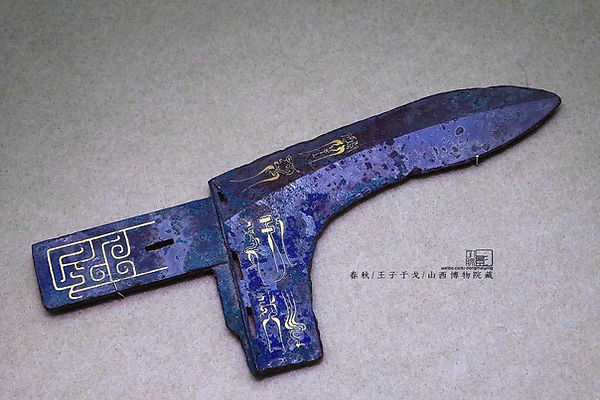
Unearthed Bronze Weapon Ge of the Spring and Autumn Period with Inlaying Gold Patterns and Inscriptions (Wang Zi Yu Ge) — Shanxi Museum (Photo by Dongmaiying)
Warring States Period — Epoch of Endless Annexation Wars and Great Reformers
After hundreds of years of intensive fights over hegemony, seven powerful kingdoms were left, plus a small central Zhou government.
This was the Warring States Period (403 BC — 221 BC) when might determined one's ability to gain power and land through force, and the former ideals of decency and etiquette gave way to conspiracies and wars.
During this period, former lords proclaimed themselves as kings, establishing their territories as independent kingdoms. The primary goal of most kings was to conquer other kingdoms and unify China.
While these former vassal states expanded into powerful, independent kingdoms, the central Zhou government, their suzerain, faced a contrasting fate as it continued to shrink.
The last king of Zhou only held sway over his capital city and approximately 30,000 civilians, while formidable kingdoms like the State of Qin commanded armies of over a million soldiers.

Unearthed Jade Mythical Animal of the Warring States Period — The Metropolitan Museum of Art (Photo by Dongmaiying)
After the passing of the last king of Zhou in 256 BC, the king of Qin seized Zhou's capital city, marking the official end of the Zhou Dynasty.
Meanwhile, fueled by a great eagerness to triumph, each kingdom sought to attract talented individuals during a period when many great reformers emerged, making exceptional contributions.
Among these reformers, Shang Yang stood out as the most influential, endowing the State of Qin with the most advanced system and formidable military forces through his transformative reforms.
Subsequently, General Bai Qi led Qin's army and significantly weakened the strengths of the other six kingdoms.
Following these events, the State of Qin emerged as the strongest empire and successfully defeated the other six kingdoms.

Measuring Vessel Implemented in the Reform of Shang Yang — Shanghai Museum (Photo by Dongmaiying)
Qin Dynasty — Transient Great Empire and Constructions of World Wonders
An ambitious and exceptional king named Ying Zheng ascended to the throne and became the King of State Qin.
With the remarkable assistance of General Wang Jian, Ying Zheng vanquished the other six kingdoms, establishing the first unified feudal imperial empire – the Qin Dynasty (221 BC — 207 BC) – and declaring himself the first emperor in China, known as Qin Shi Huang.
The Qin Dynasty, though brief, was a glorious era that brought the ideology of unification and implemented an advanced governance system.
Qin Shi Huang, one of the greatest emperors in Chinese history, unified currency, measurements, and language nationwide.
He also commissioned the construction of the Great Wall to defend against the Xiongnu in the north and the Terracotta Army to guard his underground mausoleum.
Following his passing, various uprising armies emerged, comprising peasants, civilians, and nobles of the former perished kingdoms.
Together, they successfully overthrew the rule of the Qin Dynasty.

Terracotta Warriors and Horses of the Mausoleum of Qin Shi Huang, Photo by Zhao Zhen.
Han Dynasty — Splendid Era of Legendary Civilians
In the late Qin Dynasty, uprising armies buried the Qin Empire, continuing to engage in conflicts until Liu Bang led his army, defeated rival forces, and established another unified empire – the Han Dynasty (202 BC — 220 AD).
The Han people, constituting the majority ethnic group in present-day China, derived their name from this dynasty.
Liu Bang, the founder emperor of the Han Dynasty, was a civilian. His remarkable journey from an ordinary peasant to the founder of a vast empire set a precedent for capable individuals.
Distinguished from previous aristocratic eras, the Han Dynasty saw the rise of talented and influential civilian or slave-born figures, including emperors, queens, generals, and officials, who were not suppressed by their class origins.
Emperor Wu of Han, recognized as one of the most accomplished monarchs, defied traditional norms by marrying the slave-born singer Wei Zifu as his queen.
Additionally, he appointed Wei Qing, originally a hostler, as a general and commanded Zhang Qian to open up the Silk Road.
Under the leadership of General Wei Qing and his nephew Huo Qubing, the Han Dynasty achieved significant military victories, defeating the formidable Xiongnu and vastly expanding its territory.

Brocade Barcer of the Han Dynasty — Xinjiang Museum (Photo by Dongmaiying)
In 8 AD, a regent named Wang Mang seized the throne and established a new empire. Implementing a series of radical policies, he appeared like a possible time traveler.
However, his reforms failed to bring the promised prosperity and happiness, leading to the rise of many uprising armies.
One such rebellion was led by a peasant named Liu Xiu, a descendant of the royal family of the Han Empire. Successfully defeating other troops, Liu Xiu reestablished the Han Dynasty, ensuring its continuation for another two centuries.
In the following decades, the eunuch group and empress dowagers' clans gained more power, gradually involving themselves in and manipulating politics as other officials competed for authority.
The last emperor, Liu Xie, faced struggles with powerful eunuchs and was later controlled by strong overlords.
After his final counterattack failed, he was forced to abdicate the throne, marking the official end of the Han Dynasty.

Dragon Shaped Jade Decoration of the Han Dynasty — Xuzhou Museum (Photo by Dongmaiying)
Three Kingdoms, Jin, Northern and Southern Dynasties — Turbulent Era with Powerful Aristocrats and Brilliant Artists
After the fall of the unified Han Dynasty, China entered a period of separation characterized by coexisting regimes engaged in continuous conflict.
This era witnessed the Three Kingdoms (220 — 280), the Jin Dynasty (265 — 420), and the Northern and Southern Dynasties (420 — 589).
Despite each kingdom occupying different regions of China and engaging in ongoing conflicts, none succeeded in unifying the nation and establishing a unified empire akin to the Qin and Han Dynasties.
Moreover, this period was marked by aristocracy and manorial economies.
Nobles amassed significant power and land, while an increasing number of people became slaves.
As a result, political power became strictly confined to aristocratic clans, with family origins once again taking precedence over individual ability.
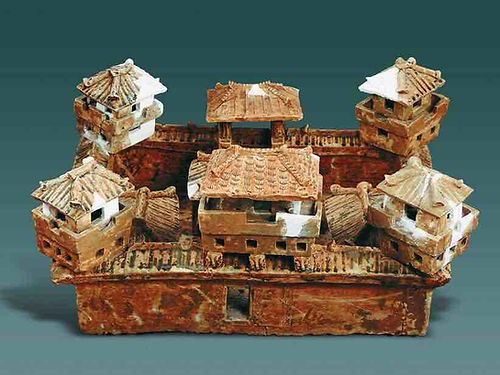
Pottery Model of Noble's Fortress (Wu Bao) of the Three Kingdoms Era — Wuhan Museum
Meanwhile, essential ideologies such as Confucianism and the Divine Right of Kings were severely challenged and suppressed.
Consequently, intelligent and well-educated individuals sought solace in nature, Taoism, or metaphysics. They turned their focus to art, literature, and alcohol, finding the endless wars and chaos to be an unfavorable environment for realizing their noble political ambitions.
In the southern kingdoms, steady growth occurred, fostering both cultural and economic development.
While in the North, a great but sad king named Yuan Hong implemented reforms that promoted national amalgamation, economy, and politics.
Decades later, this divisive period came to an end through the efforts of a northern king named Yang Jian, who defeated other kingdoms and established a unified empire named Sui.
Read More Three Kingdoms, Jin, Northern and Southern Dynasties
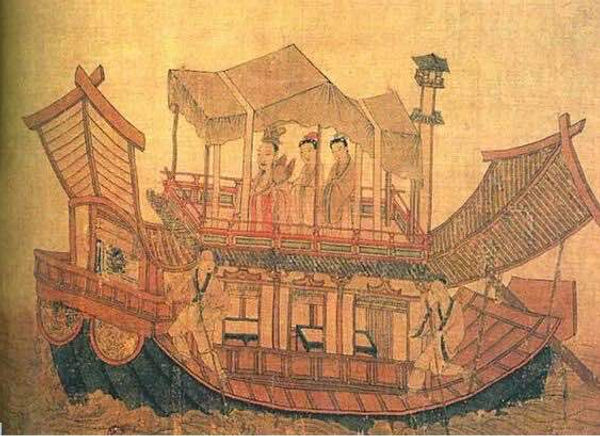
Exquisite Boat on Part of The Picture of the Ode of the River Goddess, by Great Poet and Artist Gu Kaizhi (348 — 409) of the Jin Dynasty
Sui Dynasty — Ephemeral Splendor and Exceptional Innovations
The Sui Dynasty (581 — 618) was established by Emperor Yang Jian and his beloved Queen Dugu.
This era was characterized by wealth and innovation. The dynasty built the Imperial Examination System and the Grand Canal, established a political system that endured for the following millennium, and excelled in agriculture, construction, technology, and science.
However, despite its wealth and achievements, the Sui Dynasty was short-lived.
Emperor Yang Guang, inheriting a wealthy and stable empire from his father, implemented radical policies that, though not theoretically wrong, ultimately led to the downfall of the dynasty.

Copper Mirror of Sui — Shaoxing Museum (Photo by Dongmaiying)
Tang Dynasty — Poetic Golden Era
In the late Sui Dynasty, a noble named Li Yuan claimed that he would bring peace to the country. He welcomed the late Emperor Yang Guang's grandson and respected him as the monarch.
The following year, Li Yuan took over the throne and established the Tang Dynasty (618 — 907). His son, Li Shimin, the second emperor of the Tang, led the army to unite the nation, ushering in a remarkable reign.
They ushered in a new chapter in Chinese history, securing a considerable territory, advancing science and the economy, constructing fabulous cities, fostering the prosperity and happiness of civilians, nurturing open-minded aristocrats, and witnessing the emergence of significant poets.
Li Shimin's favorite son, Li Zhi, the third emperor of the Tang, continued the development of the empire. He married Wu Zetian, one of his father's imperial concubines, and nominated her as the new queen.
Following Li Zhi's passing, Wu Zetian controversially abolished her sons and claimed the throne as the first and only female emperor in Chinese history.

Unearthed Gold Card in the Mount Song, Writing that Emperor Wu Zetian Prays for the Forgiveness from Deities about All the Sins that She had Committed — Henan Museum (Photo by Dongmaiying)
As a great sovereign, Wu Zetian left a wealthy and prosperous empire to her grandson, Li Longji.
Under the exceptional reigns of these monarchs, the Tang Empire continued to flourish.
After Emperor Li Longji met Lady Yang, his favorite woman, he ceased being the diligent and excellent monarch he used to be. Entrusting the empire to the hands of incapable and flattering officials, he chose to live a luxurious and happy life with her.
His negligence ultimately led to the destructive An-Shi Rebellion, lasting eight years and claiming millions of lives.
This marked a significant turning point when the Tang Dynasty transformed from a super prosperous empire to a declining nation.
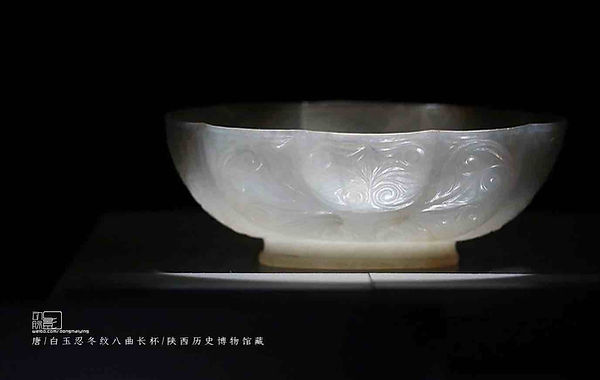
Jade Cup of the Tang Dynasty Carved with Lonicera Japonica Pattern — Shaanxi History Museum (Photo by Dongmaiying)
Afterward, the primary goal of successive emperors of the Tang Dynasty was to recover the splendid prosperity they once had. However, despite their efforts, none of them achieved this beautiful goal.
Consequently, in the late century of the Tang Dynasty, some excellent emperors managed the empire well and ushered in prosperous reigns, while others, incapable ones, seriously worsened its condition.
A series of ups and downs later, the mighty Tang Dynasty finally came to an end after the destructor Zhu Wen assassinated almost the entire royal family and destroyed the fabulous capital city of Chang'an.
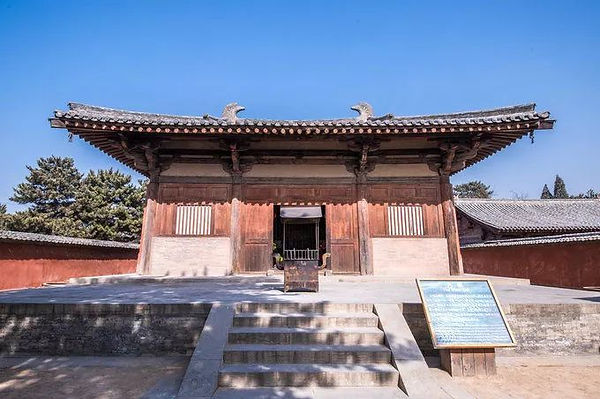
Nanchan Temple of Tang Dynasty in Mount Wutai, Rebuilt in the Year 782, Photo from qyer.
Five Dynasties and Ten Kingdoms — Epoch of Separation and Incessant Wars
After the Tang Dynasty ended, many generals refused to comply with the evildoer Zhu Wen.
Consequently, they established their independent kingdoms, plunging the entire nation into separation once again.
This marked the beginning of the Five Dynasties and Ten Kingdoms Period (907 — 979), during which over 15 regimes were established and then perished.
As one of the most chaotic periods in the history of China, war became the central theme.
It continued until a remarkable general named Zhao Kuangyin established a new regime and unified the middle kingdom, finally bringing an end to this dark era.


Night Revels of Han Xizai, by Gu Hongzhong (910 — 980) of Five Dynasties and Ten Kingdoms.
The Copied Version in the Song Dynasty (960 — 1279) is Preserved in the Palace Museum.
Song Dynasty — Wealthy and Artsy Empire
The Song Dynasty (960 — 1279) remains a dynasty with controversial historical comments.
It was extraordinarily wealthy and open-minded, with every aspect developed to an advanced level. However, this empire, despite its much smaller territory, faced strong enemies and encountered tremendous tragedies.
Beyond the Middle Kingdom of the Song, several coexisting nomadic regimes, such as the Liao Dynasty, Jurchen Jin Dynasty, Dali Kingdom, Western Xia, and the Mongol Empire, were engaged in conflicts against the Song.
It was a dynasty in which the power of the emperor and generals was restrained, while scholar-officials were highly respected.
Moreover, many emperors of the Song Dynasty, regardless of their proficiency as monarchs, were extraordinary artists.
Since Emperor Zhao Kuangyin built the Song Dynasty in the year 960, the empire thrived, and civilians lived in peace and prosperity.

Part of Painting (Wen Hui Tu) by Emperor Zhao Ji (1082 — 1135), Presenting the Feast of Intelligent Scholars — Taipei Palace Museum
Until the destructive Incident of Jingkang erupted in 1126, with the invasion of the Song Empire's capital by the formidable Jurchen Jin's troops.
After a series of ill-advised decisions made by emperors Zhao Ji and Zhao Huan, the Song Dynasty failed.
The entire royal family of Song, including these two emperors, was captured and humiliated. Large numbers of civilians lost their lives, and half of Song's territory was occupied by Jurchen Jin.
The pride, dignity, and stable lives of many people were mercilessly taken away.
A prince named Zhao Gou luckily escaped to southern China and reestablished the Song Dynasty there.
However, for various complicated reasons, he executed the most capable general, Yue Fei, losing the last chance for revenge for his captive father and the entire family.

Emperor Zhao Gou's Imperial Edict Wrote to Yue Fei, Appraising His Loyalty and Exceptional Achievement — Taipei Palace Museum
Afterward, despite the ambitions and efforts of many to avenge and reclaim their lost lands and dignity, this dream remained unrealized.
The much smaller Song Empire remained wealthy and prosperous.
However, it consistently faced underestimation and criticism due to its perceived incompleteness.
Decades later, the formidable Genghis Khan and his aggressive troops strengthened in the north, with the Mongol Empire expanding through wars. They allied with Song, defeated Jurchen Jin, and initiated invasions against Song.
After decades of intense, heroic wars, the last emperor of Song and tens of thousands of his people all sacrificed.
With that, the Song dynasty met its solemn end.

Part of Exquisite Embroidery Clothes of the Southern Song — Fujian Museum (Photo by Dongmaiying)
Yuan Dynasty — The Era of Half Anarchy
The Yuan Dynasty (1271 — 1368), established by Kublai Khan, boasted a vast territory and numerous vassal states, due to their exceptional military achievements.
During the 97 years of Yuan's rule, it saw the reigns of 11 emperors. Kublai, as the emperor for 23 years, and the last emperor, Toghon Temür, who wore the crown for 38 years, had notably long reigns, while each of the others ruled for very short terms.
As the nobles vied for the throne, engaged in invasive wars, and battled rebel forces, their focus shifted away from regular governance, leaving civilians overlooked.
The Imperial Examination was also canceled, which ensured the ruling class was exclusively Mongolian nobles.
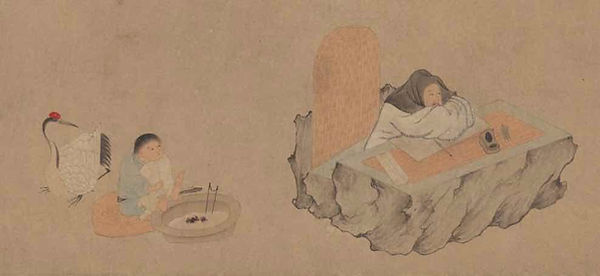
Part of Painting (Xi Hu Yin Qu Tu), by Artist Qian Xuan of the Yuan Dynasty — The Palace Museum
Since they could not participate in politics, many intelligent, well-educated people stayed as commoners in the civilian world.
Except for those who started to write drama, which appeared and flourished in the Yuan Dynasty.
Despite the era of half-anarchy, it proved ineffective. By the end of the Yuan Dynasty, numerous uprising armies emerged nationwide.
Yuan Empire's last emperor Toghon Temür was very good at astrology. After carefully reading the stars, he led his Mongolian nobles and army and escaped northward when an uprising army was marching toward his capital city.
From that moment onward, the Yuan Dynasty's status as a national regime came to an official end.

Observatory Constructed During Yuan Era in the Mount Song
Ming Dynasty — Era of Mighty, Glorious, and Dignified
A poor orphan who had once begged for food joined an uprising army at the end of the Yuan Dynasty. Over time, he garnered support from intelligent generals and brave soldiers, eventually changing his name to Zhu Yuanzhang.
After years of intense fighting, his army defeated opposing forces, overthrowing the Yuan Dynasty and unifying the nation.
The Ming Dynasty (1368 — 1644) that he established marked another golden era in China's history—substantial, honorable, productive, prosperous, and well-developed.
It was a period with exciting stories of many glorious people, an era when officials could criticize and argue intensely with emperors without losing their lives, and a dynasty when ministers were bold and considered challenging the monarch honorable and respectful.

Part of Painting "Prosperous City Nanjing of Ming" (Nan Du Fan Hui Tu), By Ming Artist Qiu Ying (1497 — 1552) — National Museum of China
After Emperor Zhu Yuanzhang passed away and bequeathed the throne to his grandson, his fourth son seized power through war.
The new monarch, Zhu Di, relocated Ming's capital city to Beijing and erected the Forbidden City.
Subsequently, all successive emperors resided in this royal palace.
Decades later, Emperor Zhu Qizhen led a robust troop, marched northward indiscreetly, and encountered a major failure, resulting in his imprisonment and the demise of the Ming Empire’s strongest main force.
Soon, Beijing came under siege and attack.
Fortunately, a remarkable minister named Yu Qian saved the Ming Empire from this life-and-death crisis. Subsequently, everything got back on track.

Ming Dynasty Great Wall
During this flourishing period, another great Neo-Confucianism philosopher, Wang Yangming, established the School of Minds, and an exceptional prime minister, Zhang Juzheng, implemented a successful reform that improved the lives of the people.
Then, the Ming Empire began to decline during the later years of Emperor Zhu Yijun’s reign.
When the last emperor of the Ming Dynasty, Zhu Youjian, ascended to the throne as a teenager, he had to grapple with long-term natural disasters, partially conflicting and continuous refugee-peasant uprisings, and a powerful nomadic regime named the Manchu in the northeast.
Years of diligent and difficult work didn’t save or reverse the situation.

Exquisite Carved Lacquer Tray of the Ming Dynasty — Zhejiang Museum (Photo by Dongmaiying)
After a refugee army breached Beijing City, Emperor Zhu Youjian committed suicide in a futile attempt to ensure his people's safety.
Following this, an important general of the Ming Empire, Wu Sangui, opened the gate of the Shanhai Pass—a crucial military stronghold—allowing the Manchu army to march across the Great Wall.
Millions of people remained loyal to the Ming Dynasty, supporting some princes of Ming as new kings and persistently fighting against the Manchu army.
Decades of countless intense wars and massacres later, they all failed.
The Manchurian ruling class buried numerous documents detailing the slaughter, enforced changes in clothing and hairstyle for everyone, and established a new national regime.
The Ming Dynasty officially came to an end.

Plum Shaped Agate Cup of Ming — Wuhan Museum (Photo by Dongmaiying)
Qing Dynasty — Centralized Autocracy and the Last Imperial Empire in Chinese History
The Qing Dynasty (1636 — 1912), the last feudal empire in the history of China, represented the most authoritarian era, where the emperor held sway over everything.
The ruling class deviated from the previous civil officials chosen through the Imperial Examination, instead reverting to a nomadic aristocrat-dominated system.
In this new system, the Imperial Examination persisted, but the Manchu nobles wielded absolute centralized power, enjoying numerous privileges.
During the reign of the Qianlong Emperor hundreds of Literary Inquisitions were implemented, leading to the execution of countless individuals and the burning of millions of books that displeased the Manchu nobles.

Gem Decorated Gold Ceremonial Wine Cup (Jin Ou Yong Gu Bei) of the Qianlong Emperor — Palace Museum (Photo by Dongmaiying)
After the cultural havoc, the Qing Dynasty began to decline, falling far behind the Western world.
Since the Qing lost in the First Opium War, also known as the First Anglo-Chinese War, in 1842, China entered one of the darkest periods in its history.
The Qing Dynasty continued to face defeats against England, France, America, Japan, and many other advanced Western countries.
Following these military failures, the Qing signed a series of unequal treaties and paid large amounts of war indemnities.
Until the Qing Dynasty was overthrown in the year 1912, and the Manchu clothes and hairstyle were finally abolished.

Exquisite Cloisonne Jars with Gilding Lidand Jade Pieces of Qing — Palace Museum (Photo by Dongmaiying)
Dark Period of Losing, Humiliating, and Exploring
The Republic of China was established in 1912 and unified the nation in 1928.
During this era, warlords engaged in conflict, and foreign forces sought to maximize their interests.
Then, Japan invaded in 1931.
Every inch of Chinese land had experienced intense fights and witnessed countless blood and sacrifices. This was part of the Second World War, which ended in 1945.
Over 35 million Chinese, including soldiers and civilians, lost their lives during this period.
This time was dark for the Chinese, not only due to countless failures, sufferings, and significant population and economic losses, but more importantly, it marked a colossal collapse of cultural confidence.
They were uncertain about their ability to reverse the lagging-behind, desperate situation and regain independence, prosperity, peace, and dignity.
Now
The People's Republic of China was established in 1949 after the Kuomintang, the ruling party of the Republic of China, failed and fled to Taiwan.
China has experienced ups and downs since then.
It's never easy to provide a concise description of the society we live in now, as everyone has their views and opinions.
History needs to be discussed, investigated, and testified by large numbers of people and an abundance of potential new information over time.
However, one undeniable fact is that the Chinese are striving to regain lost confidence, dignity, and glory, step by step.

Sunrise Scape on Top Peak of Mount Tai, Photo from Official Site of Taishan.
